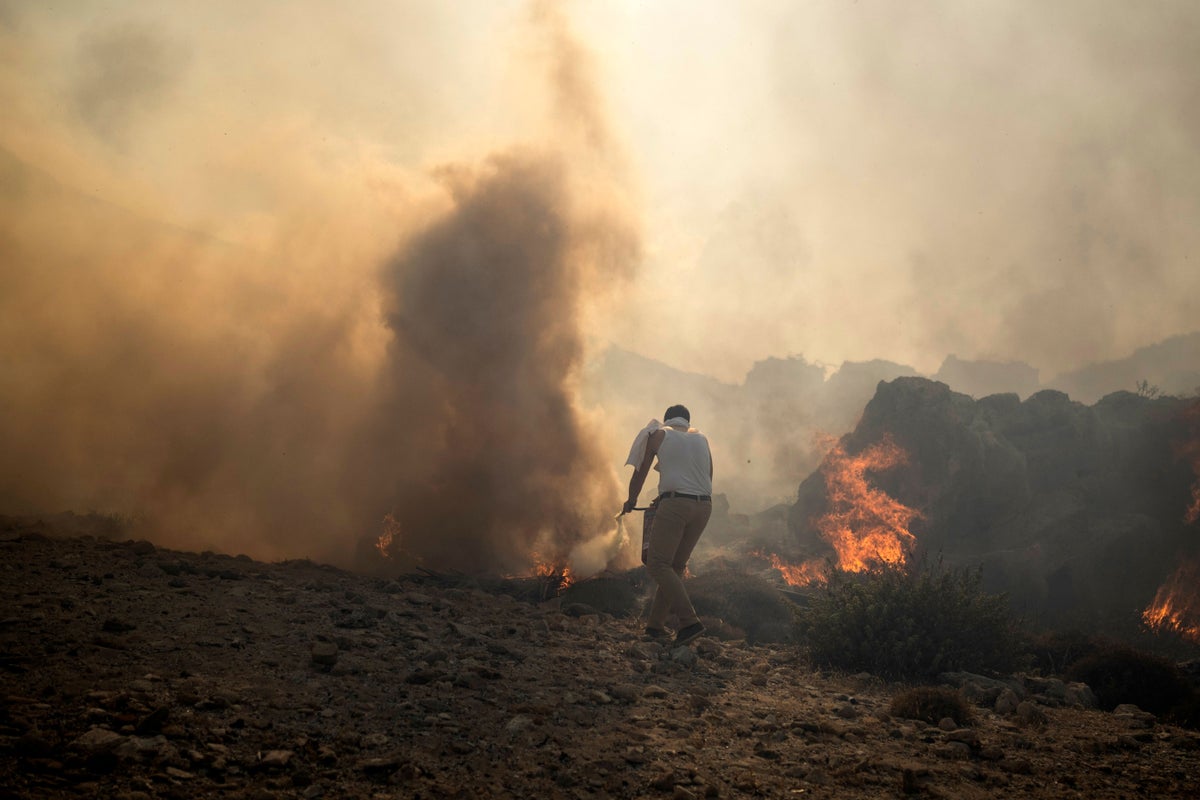
Wildfires have raged across Greece for seven consecutive days, triggering large-scale evacuations, rescue flights for British tourists and warnings from officials that things may yet get worse.
While the cause of the blazes has not officially been identified, local authorities have suggested at least some could have been the work of arsonists.
But climate science and fire risk specialists say it’s undeniable that rising temperatures and prolonged heatwaves mean the fires in the Mediterranean country have spread faster and burned over larger areas.
Why are the wildfires so severe in Greece?
Over the past few weeks, forest fires have erupted in several parts of Europe – including Switzerland, Italy, Turkey, Croatia, and Spain – as a heatwave sweeps the continent.
But Greece has been the worst hit. According to a government spokesperson, an average of 50 wildfires broke out daily for 12 consecutive days in July, with 64 recorded in one weekend.
Dr Matthew Kasoar at Imperial College’s Leverhulme Centre for Wildfires, Environment and Society told The Independent that the tinder-dry conditions would make it easier for them to spread.
He said: “Fire risk increases rapidly when there are periods of prolonged hot weather, which allow the soil and vegetation to completely dry out.”
“Climate change has increased the severity, frequency, and duration of heatwaves when they occur,” he added, as temperatures on the southern Greek mainland rose as high as 45C (113 degrees Fahrenheit) this month.
Emergency services trying to put out wildfires on Rhodes (Sarah George/PA)— (PA Media)
“A lot of the wildfires we’re seeing in Greece have been in areas with shrubby vegetation,” climate science expert Dr Nigel Arnell said.
A study by the University of Florida found that spot fires tend to spread further from their original fire perimeter in areas where woody plants such as shrubs and trees replace herbaceous plants like grasses.
Is human-induced climate change responsible for the fires?
Cambridge professor Adam Pellegrini, who is an expert in forest ecosystems and climate change, said that one of the best examples of anthropogenic, or human-caused climate change contributing to fire activity comes from the western United States.
“A 2016 study looked at the area that was burned in a year in the western forests, as well as weather and aridity condition,” he explained. “The researchers ran a model that simulated climate with and without anthropogenic [greenhouse gas] emissions.
“Under these climate simulations, which have uncertainties, they found there was a high likelihood that you wouldn’t see these fires that we see now, without climate change,” Dr Pellegrini continued.
A local man uses a tree branch to beat down the flames of a wildfire near the village of Vati, just north of the coastal town of Gennadi, in the southern part of the Greek island of Rhodes— (AFP/Getty)
The study showed that human-induced climate change contributed to an additional 4.2 million hectares of forest being affected by fire during 1984–2015 – double the forest fire area expected without it.
“That was done in the western US but those are the kinds of analyses that are required [for the wildfires in Europe]”, Dr Pellegrini said. “My guess is people will now be trying to do that.”
An analysis by the World Weather Attribution network found that the recent heatwaves in Europe and the United States would have been “virtually impossible” without human-caused climate change. According to the study, climate change meant this year’s heatwave in Europe was 2.5C hotter.
Are these extreme weather events preventable?
The way to reduce the increase in heat and drought, and the frequency with which they occur, is stopping greenhouse gas emissions, Dr Pellegrini said, adding: “That is the number one way to do it.”
A firefighter looks on during a fire near the village of Vati, just north of the coastal town of Gennadi, in the southern part of the Greek island of Rhodes on July 25, 2023— (AFP via Getty Images)
Better ways to adapt and mitigate the damage from wildfires include controlled burns during a cooler, wetter time of the year. “That way you burn out the fuel for the fires, so if there’s a really hot and dry year, hopefully a forest fire won’t be as intense,” he added.
Limitations include the high cost of controlled burns, as well as accessibility issues in remote areas such as Siberia, where forest fires have raged since last year.
Another way to reduce fire risk is through animal grazing, Imperial College researcher Oliver Perkins explained. “In fire-prone regions of Spain, goat farmers are paid, not to produce food but, to reduce fire risk by grazing flammable vegetation.”
Is there a threat of wildfires in the UK?
Dr Kasoar warned that almost every region in the world is facing more intense and more frequent hot weather, and the UK is no exception.
Volunteers cool themselves during a wildfire in Vati village, on the Aegean Sea island of Rhodes— (AP)
“We have seen record-breaking heat and fires in the south of the UK last summer, and with the country’s largest fires being recorded in the last few years,” he added. “Unless we stabilise global temperatures by reducing global emissions to net zero, wildfires will continue to become an ever more present risk here in the UK and across many other parts of the world.







